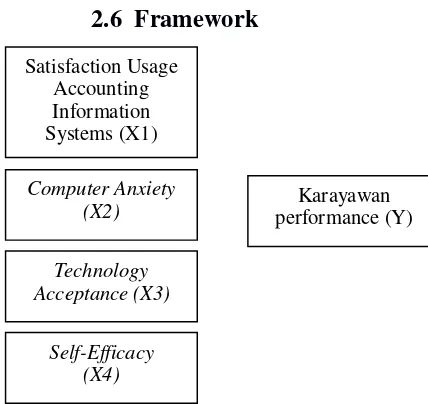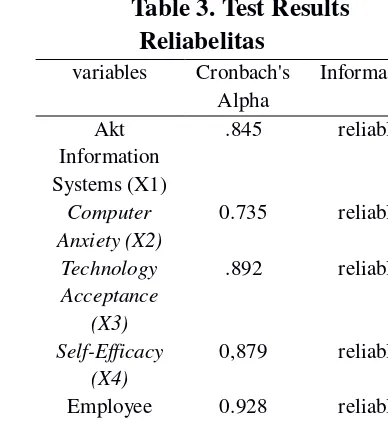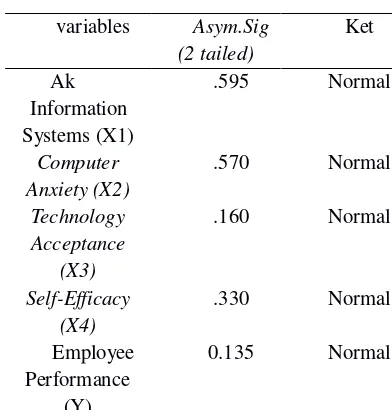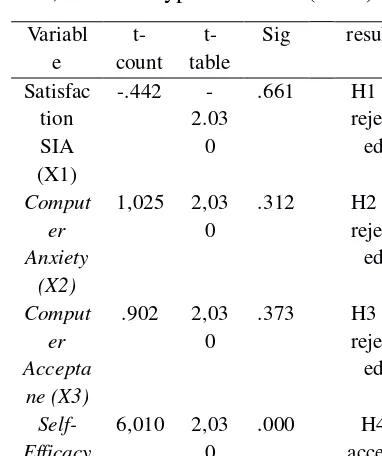Satisfaction Influence Use of Accounting Information Systems, Computer
Anxiety, Technology Acceptance and Self-Efficacy Against Employee
Performance PT. Delta Dunia Textile Sukoharjo
Dinda Elnusa Try Atmaja1, Siti Nurlaela2, Yuli Chomsatu Samrotun3
1,2,3
S1 Accounting Study Program, Faculty of Economics, Universitas Islam Batik Surakarta Jl. KH. Agus Salim No. 10, Surakarta, Indonesia
E-mail: Dindaelnusa97@gmail.com
Abstract: This study aims to determine the effect of satisfaction is the use of Accounting Information Systems, Computer Anxiety, Technology Acceptance and Self-Efficacy against Employee Performance PT. Delta Dunia Textile Sukoharjo. This research was motivated by the importance of the application of information technology, the anxiety in using the technology, benefits and ease in operating the company's information technology. With the quality and performance of employees both in the mastery of information technology it will be a good contribution to the company, so as to compete competitively with other companies. This study is located in one of the companies in Sukoharjo. Used a sample of 40 respondents with sampling using purposive sampling technique. The results showed; (1) There is no effect between satisfaction Usage Accounting Information Systems on Employee Performance, (2) there is influence between Computer Anxiety on the Performance of Employees. (3) There is influence between the Technology Acceptance the Employee Performance, (4) There is influence between Self -Effivcacy the Employee performance.
Keyword: Accounting information system; Computer Anxiety; Technology Acceptance; Self-efficacy; Employee performance
1. PRELIMINARY
The era of globalization resulted in the rapid technological developments. It is of course also result in increasing competition in the business world. Competitive advantages created by the company can be reached by one way, namely improving the performance of employees and the ability of employees to run the technology and systems that
already exist in the company. Reliable accounting information system is one way to improve the quality of employee performance, as an accounting information system designed to produce financial information used by the wearer in important decision-making process in a company.
consisting of a smaller entity, which relate to each other and have a purpose tertentru. An input processing system (inputs) into outputs (output). Input accounting system is evidence of transactions in the form of a document or form. Output of whom are financial statements according to Nurlaela & Rahmawati, (2010).
2. LITERATURE REVIEW
2.1 Satisfaction Usage Accounting Information Systems
a. Satisfaction
According Khotler (2000) definition of satisfaction isone's feelings about pleasure or disappointing results from comparing the appearance of a product that has been provided (result) in dealing with the expectations of customers. Thus fully customer satisfaction does not mean give what we think of their desire, but what they really want and when and how they want.
Satisfaction use of an assessment as to whether the performance of an information system was relatively good or bad, and whether the information system presented compatible or incompatible with the purpose of the wearer. In general, user satisfaction is the result of the user perceived
performance of a system that is operated in accordance with their expectations. Users are satisfied when their expectations are met. Satisfied users tend to remain loyal longer and relatively more frequent use by Chai & Pavlou (2004)
b. Information Systems
The system is a entitty (unity), which consists of interrelated parts or so-called subsystems which aim to achieve certain goals by Wahyono (2004). The information system recommends the use of computer technology in the organization fatherly present information to the user. Computer-based information system is a group of hardware and software designed to transform data into useful information.
equipment, and computer equipment and protocol standards such as ANSI X.12, it is important for the office automation and rapid response systems. The function of the information system, any organization that uses computers to process transaction data functions of information systems. Information system functions responsible for data processing. Data processing is the application of accounting information system of the most fundamental in every organization. The function of information systems in organizations has evolved from a complex structure which includes many specialists who qualified opinions Bodnar and Hopwood (2000)
c. Accounting information system
Accounting Information Systems is a collection of resources such as people and equipment that is set to transform data into information the opinion of Bodnar and Hopwood (2000). Parjanti, et al., (2014) states the role of information technology for accountants in applying accounting information system, which includes:
1) Information technology helps accountants to complete their obligations more quickly, accurately and consistently.
2) Some of the latest information technology can assist in the development and integration of accounting files, evaluating internal control in the AIS and the variation application software packages.
3) Computer networks deliver data and information, so that is an integral part of the SIA.
4) The computer network will be developed that will help the user with a variety of financial information.
of the opinion Wahyono (2004)
2.2 Computer Anxiety
Definition of Computer anxiety by Igrabia & Parasuraman (1989) is as a person's tendency becomes difficult, worry or fear about the future use of information technology sekanag or in the future.
Wiramirhardja (2005) states that anxiety is a feeling where the person feels fear or loss of confidence was not clear origin and its form so as not bold and able to behave rationally and act in accordance with what should be done. When connected to a computer using the computer anxiety is an expression of negative feelings or excessive presumption about the difficulties caused by the use of computers led to antipathy towards computers
2.3 Computer Acceptance
TAM concept was developed by Davis (2004) offer a theory as a foundation for studying and understanding the behavior of users to receive and use information systems. This model has the aim to explain the key factors of the behavior of users of information technology to the acceptance of the information technology adoption. TAM concept expansion is expected to help
predict a person's attitude and acceptance of the technology and can provide the necessary basic information about the factors that pushed the attitude of the individual.
Wulandari & Sons (2015) argues Technology Acceptance Model is one of the aspects of the perceived benefits used by the user, user attitude towards the use of technology, know the ease of use (ease of use), benefits (usefulness), attitudes and behavior of users of computerized systems either device hardware and software are applied. The design of the study is exploratory data analysis with qualitative and quantitative processing. That is an attempt to discover and classify about a phenomenon or social reality.
2.4 Self-Efficacy
Computer Self Efficacy is an individual assessment of the ability to use a computer, according to Indriantoro (2000) Computer Self Efficacy is the ability of individuals to use computer applications, operating systems, hardware and file handling, storage and use keyboard keys. An individual's expertise in using a computer is a reference of the individual in the context of the use of information technology.
be seen in three dimensions, namely:
1) Level (level) Self-efficacy individuals in doing a different task in the level of difficulty of the task. Individuals have a high self-efficacy in an easy and simple task, or also on the tasks are complex and require high competence. Individuals who have high self-efficacy tend to choose the difficulty level of the tasks according to his ability.
2) Breadth (generality) This dimension relates to the individual mastery of the field or job duties. Individuals can declare itself has self-efficacy on a broad activity, or limited to specific domains function. Individuals with high self-efficacy will be able to master several fields at once to complete a task. Individuals who have a low self-efficacy only control bit field is required in completing a task.
3) Strength (strength) The third dimension is more emphasis on the level of strength or stability of the individual against his conviction. Self-efficacy showed that actions by individuals will deliver results in accordance with the expected individual. Self-efficacy is the basis of
effort he did, even when confronted with obstacles though. From the above it can be concluded that self-efficacy include dimensional (level), breadth (generality) and power (strength).
2.5 Employee performance
Definition of managerial performance is the result of the process of managerial activities that are effective, efficient and cost-effective start of the planning process, implementation, administration, reporting accountability and supervision according to Setiawan, et al., (2016)
2.6 Framework
Figure I.1 Framework for Thinking
2.7 Hypothesis
1) Effect of Accounting
Information System Usage Satisfaction on Employee Performance
Parjanti, et al., (2014) in his research indicates that the variable X1 in the study are Accounting Information Systems and significant influence on employee performance. These results indicate that the better the information systems in an organization, it also increase the performance of employees in the company. H1: Accounting Information System Usage Satisfaction berpengaru the Employee Performance.
2) Influence of Computer
Anxiety on Employee
Performance
Sudaryono (2015) The relationship between
computer anxiety with computer literacy in the framework of this thinking digambarkann that computer anxiety has a negative influence on computer skills. Computer users with high anxiety computer will show the level of computer literacy is lower, with the results of computer anxiety has no effect on the expertise in using the computer.
H2: Influence of Computer Anxiety on Employee Performance
3) Computer Acceptance
influence the Employee Performance
Widjana & Rachmat (2014) states that the perceived ease of use has a positive effect on perceived enjoyment. This condition is due to that the easy to use internet banking, the customer is getting happier and enjoy internet banking. Also significant relationship between perceived usefulness and attitude towards the use of internet banking, customers will have a positive acceptance of internet banking when customers feel that using internet banking to benefit customers. Perceived ease of use and attitudes towards the use of Internet banking
Satisfaction Usage Accounting Information Systems (X1)
Computer Anxiety (X2)
Technology Acceptance (X3)
Self-Efficacy (X4)
also has a significant relationship. This happens because customers who feel that it is not easy to use internet banking will tend to have an attitude of rejection, while customers will have a positive acceptance of internet banking at a time when customers feel that using internet banking is very easy.
H3: The Effect of Acceptance the Employee Performance Computer
4) Influence of Self-Efficacy
against Employee
Performance
Princess Ardi, et al., (2017) Self-efficacy has a significant influence on employee performance. With, smaller than the significance level of alpha value and t> t table. These results indicate that the self-efficacy can have a positive influence on employee performance.
H4: The Effect of Self-Efficacy against Employee Performance
3. RESEARCH METHODS
3.1 Types of research
This type of research used in this study is a qualitative research with descriptive approach. Method Qualitative research is research that aims to
understand the phenomenon of what is experienced by research subjects, such as behavior, perception, motivation, act holistically, and by way of description in the form of words and language, in a specific context in which the natural and the utilizing a variety of natural methods Maleong (2010)
3.2 Variables and Measurement 1) Independent Variables (X)
X3 Technology Acceptance Model, the concept of TAM was developed Davis (2004) offer a theory as a foundation for studying and understanding the behavior of users to receive and use information systems of these variables are measured with an instrument consisting of 12 items of questions that included questions about the ease of use of the technology and benefits obtained from the use of such technology.
X4 variable of this research is Self-efficacy is a person's belief in the ability of him to do something or a specific job which it is responsible according to Bandura (1995), this variable is measured by the instrument Computer Self-Efficacy Scale (CSE), which contains 5 items of questions. Questions include the ability of the user in terms of computer applications, computer operating systems, handling of files and data storage hardware, the use of the keyboard
2) Dependent Variable (Y) Y variables in this study is that an employee performance level employees to achieve the requirements of the job
efficiently and effectively by Parjanti, et al., (2014) the measurement variable is to use questions as many as 12 items of questions
3.3 Population and Sampling
Roscoe (1975) The sample size depends on the number of population. Minimal sample by Roscoe for a population of less than 500 people represented 30 people. For samples that split again into several sub-categories of samples, such as gender, level and the like then the samples required minimum 30 samples. To study multiple regression test sample size of at least 10 times the number of variables studied, whereas for simple experimental study, the number of samples it takes about 10 to 20 samples. The population in this research is PT. DELTA WORLD TEXTILE Sukoharjo. A sample of 40 employees of the administration.
,
4. RESULTS AND DISCUSSION
4.1 Descriptive analysis
Table 1 Descriptive Test Results
Ket Min Max mean
Std Division Ak
Informatio n Systems
17.0 35.0 24.42 3.62956
computer Anxiety
18.0 35.0 25.45 3.78899
technolog Acceptanc
35.0 55.0 43.32 5.68122
Self-Efficacy
Variable Accounting Information Systems sebesar17,00 minimum value, maximum value of 35.00, the mean value of 24.4250 , The standard deviation value of 3.62956
Variable Computer Anxiety minimum value of 18.00, a maximum value of 35.00, the mean value of 25.4500 , The standard deviation value of 3.78899
Variable Technology Acceptance minimum value of 35.00, a maximum value of 55.00, the mean value of 43.3250 , The standard deviation value of 5.68122
Accounting Information Systems Variable minimum value of 12.00, the maximum value is 25.00, the mean value of18.8000 , The standard deviation value of 3.18007
4.2 Test Instruments Data
a. Validity test
Based on the results of validity test with SPSS 17 processing results can be obtained satisfaction variables Use of Accounting Information Systems 7 items, variable Computer Anxiety 10 items, 12 items Acceptance Computer variable, and the variable Self-Efficacy 5 items. With significant value 0,000 then the four variables declared invalid:
Table 2 Data Validity Test Results
variables item Sig Informatio n Satisfactio
n SIA (X1)
1-7 > 0.05 valid
Computer Anxiety
(X2)
1-10 > 0.05 valid
Computer Acceptane
1-12 > 0.05 valid
(X3) Self-Efficacy
(X4)
1-5 > 0.05 valid
b. test Reliability
Based on the results of reliability test five significant variables with Cronbach Alpha above 0.05 with each - each value of Cronbach Alpha: Satisfaction Usage Accounting Information Systems at 0.845, 0.735 for Computer Anxiety, Computer Acceptance of 0.892, Self-Effcacy amounted to 0,879 and Employee Performance amounting to 0.928. Thereby it can be concluded that all five variables are declared reliable.
Table 3. Test Results Reliabelitas
variables Cronbach's Alpha
Information Akt
Information Systems (X1)
.845 reliable
Computer Anxiety (X2)
0.735 reliable Technology
Acceptance (X3)
.892 reliable
Self-Efficacy (X4)
0,879 reliable Employee
Performance (Y)
0.928 reliable
4.3 Classic assumption test a. Normality test
already qualified normality assumption test which can be seen in the table below:
Table 4. Normality Test Results
variables Asym.Sig (2 tailed) Significance values <10 so that it can be said that the data is not mengalam multikorelasi
table 5, Test Results Multikolerasi
variables toll VIF Information Satisfacti
d. test Hetoskedesitai
The test results in the table below shows that out of the 4 variables have significant value>
0.05 thus then to 4 variables can be stated that no symptoms of heteroskedesitas
Table 6. Test ResultsHetoskedesitas
variables Sig Information Satisfaction autocorrelation Durbin Watson value of 2,219. It can be concluded that the regression model revealed there are no autocorrelation.
Table 7. The test results autocorrelation
variables Durbin Watson
4.4 Hypothesis testing
a. Multiple Regression Test
Linierr
The test results in the table below shows that the H1, H2, H3 and H4 rejected dieterima
table 8, Results Hypothesis test (t test)
Hypothesis 1: Satisfaction Uses of Accounting Information Systems has no effect on employee performance.
From the test results X1 Satisfaction Usage Accounting Information Systems t values obtained show -t table value ≤ t ≤ t table (-2.030 -0.422 ≤ ≤ 2.030) and significantly> 0.05 (0.661> 0.05), then Ho is rejected and H1 accepted thus the Accounting Information System Usage Satisfaction does not affect the Employee performance.
Hypothesis 2: Computer Anxiety has no effect on employee performance.
From the test results X2 Computer Anxiety t value shows the value of t table ≤ t ≤ t table (-2.030 ≤
Hypothesis 3: Computer Acceptance does not affect the H3 Technology Acceptance does not affect the employee performance.
Hypothesis 4: Self-Efficacy influence on employee performance. From the test results X4 Self-Efficacy t value shows the value of t table ≤ t ≤ t table (-2.030 ≤ 6.010> 2.030) and a significant <0.05 (0.000 <0.05), then Ho is rejected and H4 accepted thus, Self-Efficacy influence on employee performance.
c. Feasibility Model (Test F)
By using SPSS data processing 17, the obtained f calculated at 8.917 and the test criteria 24.188 f count> F table = 2.64 it means that there are significant co - operation between the independent variable in the form of satisfaction Use of Accounting Information Systems, Computer Anxiety, Computer Acceptance and Self-Efficacy against Employee Performance
table 9, F test results
F count F table Sig result
24.188 2.64 0.05 Eligible
d. Test the coefficient of determination
Based on the test results of determination (R2) with the value of Adjusted R Square of 73.4 5% can be concluded variables Satisfaction Usage Accounting Information Systems, Computer Anxiety, Computer Acceptance and Self-Efficacy influence a percentage contribution of 70.4% to the independent variables, Performance employees (Y), while presentas by 29.6% influenced by variables / factors not examined.
5. CONCLUSIONS
a. Conclusion
This study examines the effect of satisfaction Use of Accounting Information Systems, Computer Anxiety, Technology Acceptance, Self-Efficac the Employee Performance with a sample of 40 respondents employees of the accounting and administration of a company
Based on the results of testing hypothesis 1, hypothesis 2, hypothesis 3 and hypothesis 4 proposed in this study that states that the variable Satisfaction Uses of Accounting Information Systems does not affect the performance of the employee, it is not in line with research conducted by Parjanti, et al., ( 2014) with the result that the accounting information system affect the performance of employees. Tecnology Acceptance does not
affect the employee's performance is not in line with the results of research conducted by Pikkarainen (2004). Computer Anxiety has no effect on employee performance is in line with the results of research conducted by Sudaryono (2015) which states that the Computer Anxiety or anxiety computing the expected low so that the employee's performance will increase. While Computer Self-Efficacy variables affect the Employee Performance results are consistent with research conducted by the Princess, et al., (2017). Satisfaction Usage Accounting Information Systems. Thus the variable Computer Anxiety and Self-Efficacy supporting empirical evidence. while for the satisfaction variable usage accounting information system, Technology Acceptance mndukung no empirical evidence.
The results of this study indicate that (1) variable Accounting Information System Usage Satisfaction no effect on employee performance, (2) Variable Computer Anxiety has no effect on employee performance, (3) Variable Technology Acceptance does not affect the employee performance, (4) Variable Self- efficacy effect on Employee performance
b. Suggestion
marketing, but can also conduct research using staff administration of payroll or administration more and add some companies as a comparison between a company with perusaan others ,
2. Subsequent research it helps not only use kuoesioner and interviews, it might be able to use financial statements or concerned with accounting information useful to strengthen the conclusion.
6. BIBLIOGRAPHY
Bandura, A. (1995). Self Efficacy. The Exercise of Control. New York: WHFreeman and Company.
Bodnar, G., & Hopwood, WS (2000). Accounting information system. Jakarta: Four Salemba.
Chai, L., & Pavlou, PA (2004). From 'Ancient' to 'Modern': A Cross-cultural Investigation of Electronic Commerce Adoption in Greece and the United States. Journal of Enterprise Information Management, 416.
Davis. (2004). User Acceptance of Information Technology System; System Characteristic adn User Perception Behavior Impact. Machne Juornal Management International Studies.
Davis, V. &. (2000). Theoretical Extension of the Technology Acceptance Model; Four
Longitudinal Field Studies. Management Scient.
Igrabia, M., & Parasuraman, S. (1989). A Path Analytic Study Of Individual Characteristics, computer anxiety and atittude toward microcomputer. Journal Of Management, Vol.15, No.3.
Indriantoro, N. (2000). Influence of Computer Anxiety on Skills Lecturer in Computer peggunaan. Journal of Accounting and Auditing Indonesia, Vol.4, No. 2
Khotler, P. (2000). Marketing Management: Analysis, Planning, and Control implemntasi, trans: Hnedra Teguh and Ronny Antonius Rusly, Issue 9, Volume 1 and 2. Jakarta: PT Prenhallindo.
Maleong, LJ (2010). Qualitative Research Methods. Bandung: PT.Remaja Rosdakarya.
Mangkunagara, PA (2002). Smber Human Resource Management. Bandung: Youth Rosdakarya.
Nurlaela, S., & Rahmawati. (2010). Influence of Organizational Behavioral Factors Against Regional Financial Accounting System utilities in Subosukawonosraten. National Symposium Accounting Year XIII.
Parjanti, E., Nurlaela, S., & Titisari, KH (2014). Effect of Accounting Information Systems, Task Complexity Leadership Style on Employee Performance. Paradigm Journal, Vol. 12, No. 1, 58.
Daughter, VT, Astuti, ES, & Widyo, MC (2017). Influence of Self-Efficacy against engangement Employee and Employee Performance (Study on Employee PT. Telekomunikasi Indonesia Regional V Surabaya). Journal of Business Administration (JAB) Vol.52, No.1.
Setiawan, I., Nurlaela, S., & Wijayanti, A. (2016). Effect of Accounting and Management Information Systems Management Control Systems on Managerial Performance in Lorin Group. National Seminar IENACO, 799.
Sudaryono, EA (2015). Influence of Computer Anxiety Keahlia Employees Against Accounting section in the Use of the National KomputerSimposium Auntansi. Accounting National Symposium VIII, Solo.
Wahyono, T. (2004). Accounting Information System Analysis & Design Computer Programming. Yogyakarta: ANDI.
Widjana, MA, & Rachmat. (2014). Factor Deterrmining AcceptanceLevel Implementation Of Internet Banking. Journal of Economics, Business and Accountancy Ventura, vol.14, No2, 161-174.
Wiramirhardja, SA (2005). Psychologist Introduction Abnormal. Bandung: PT. Refika Aditama.
Wulandari, AS, & Son, IS (2015). Application Analysis of Regional Goods Management Information Systems Technology Acceptance Model Method In Blitar District Government. Accounting Students



